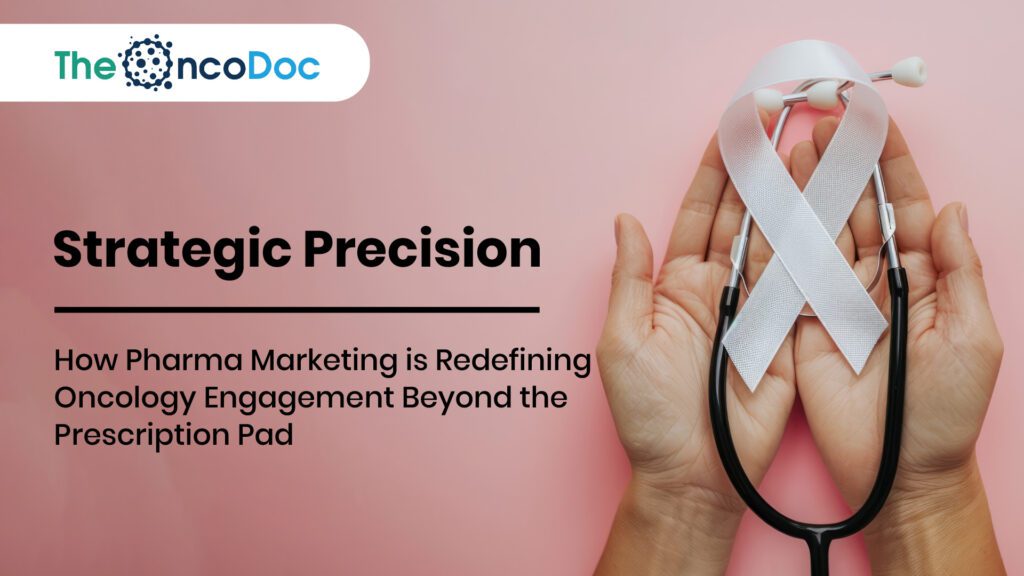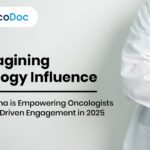1. Oncology’s Evolving Demand: Beyond Brand Recall
Oncologists today are data-saturated but insight-starved. They juggle guideline updates, patient-specific diagnostics (e.g., PD-L1, KRAS, NTRK), financial concerns, and therapy planning within a tight consult window. Traditional brand recall-based marketing fails in this environment.
Pharma brands must now ask:
- How can we reduce decision fatigue?
- What clinical gaps can we bridge in 2 minutes or less?
Shift in Strategy:
From: “Our drug has the best OS.”
To: “Here’s a summary of how this regimen impacts progression-free survival in Indian patients under 55, based on real-world usage.”
This content transformation marks the beginning of relationship-centric marketing over product-centric promotion.
2. Creating Value Through Clinical Pathway Integration
Today’s oncologist works within integrated care pathways. Every drug decision connects with diagnostics, multidisciplinary collaboration, and patient logistics. Pharma can enhance value by providing decision-support content embedded in these clinical routines.
Key Tactics:
- Visual flowcharts summarizing treatment by biomarker status
- Line-of-therapy decision trees with approval timelines
- Protocols for transitioning from oral chemo to immunotherapy
Example:
A gastro-oncologist receives an updated PDF mapping mFOLFIRINOX + Nivolumab in first-line CRC and a clickable decision aid for subsequent regimens.
Such tools make pharma a facilitator of clinical clarity, not a messenger of complexity.
3. Top Clinical Tools Requested by Indian Oncologists (2025)
📊 Graph Insight:
The bar chart reveals that oncologists in India now prioritize tools that save cognitive and administrative bandwidth, such as:
- Mutation-treatment matchers (for actionable results like ALK, EGFR)
- Regional reimbursement advisories
- Checklists for chemo infusion and AE reporting
This trend shows a growing appetite for “clinical utility as marketing”, where brands offer tangible, use-it-now resources instead of promotional PDFs.
4. The New CME Economy: What Oncologists Actually Engage With
Live CMEs are declining due to patient volume, travel challenges, and increasing digital fluency. Instead, oncologists now prefer snackable learning embedded in their natural digital routines.
CME Innovations:
- Daily Case Clues: “48F, triple-negative breast cancer, BRCA+, relapsed post-AC-T. Next best step?”
- Peer-Powered Webinars: Live sessions moderated by a regional oncologist with audience polling
- Diagnostic Quizzes: Spot-the-abnormality radiology challenges for CME credit
These formats meet oncologists where they already are-on WhatsApp, YouTube, and mobile apps-and offer real clinical stimulation, not passive listening.
5. Most Used Digital Platforms for Oncology CME (India 2025)
🥧 Graph Interpretation:
WhatsApp leads due to its ubiquity, low-data consumption, and peer community integration. App-based platforms like Hidoc Dr. and Omnicuris follow, offering structured content with CME credits.
Traditional email newsletters and hospital LMS portals lag, showing a shift from static to interactive learning ecosystems.
Pharma marketers should prioritize:
- Sequenced WhatsApp journeys (e.g., “5 days of TNBC CME”)
- CME videos that double as content for doctor-run Telegram channels
- In-app pop-ups offering contextual learning during clinical tool usage
6. Empowering the Multidisciplinary Cancer Team (MDT)
Modern oncology care is not just the oncologist’s domain-it spans radiologists, pathologists, palliative specialists, and tumor board coordinators.
Pharma’s value proposition lies in enabling this team, not just the lead prescriber.
Engagement Examples:
- Tumor board starter kits: standardized slide templates, KPI sheets
- Diagnostic algorithms that start from radiology, not therapy
- Digital case repositories for use in medical colleges
By supporting the full MDT, pharma becomes a system-level enabler-which also indirectly influences prescribing behavior.
7. Local Language + Local Logic = Greater Adoption
Translation alone isn’t enough. Pharma campaigns must reflect regional epidemiology, practice habits, and cultural context.
Examples:
- Bengal: Oral lesion red flags + betel nut chewing
- UP/Bihar: AI-powered SMS nudges on post-menopausal bleeding → cervical screening
- Kerala: Patient journey videos in Malayalam for colorectal cancer
AI tools enable this customization by analyzing:
- Local search terms (e.g., “gola mein ganth”)
- EMR data on tumor types
- Linguistic preferences of district-wise HCPs
The result: high recall, low resistance marketing.
8. Beyond the Oncologist: Empowering the Referral Chain
Early cancer symptoms rarely present first to oncologists. Yet, general physicians, gynecologists, and ENT specialists often lack structured referral training.
Pharma brands now:
- Send monthly “Symptom Signal” infographics to 5,000+ regional GPs
- Conduct vernacular CME webinars on cancer mimics
- Distribute voice-based triage modules via IV
Clinical Impact:
- Faster referrals
- Earlier-stage detection
- Enhanced oncologist-GP communication
Marketing Impact:
Pharma becomes a cross-specialty integrator, not just an oncology brand promoter.
9. KOLs in 2025: Hyperlocal, Not Just High-Profile
In a social-digital era, credibility is built vertically (deep in a region) rather than horizontally (broadly across the nation).
Micro-KOLs:
- Host 500-member city WhatsApp groups
- Share original case-based reels on Instagram
- Moderate regional LinkedIn oncology forums
Pharma now co-creates:
- Patient counseling videos featuring micro-KOLs
- Hyperlocal newsletters (“What oncologists in Nashik are seeing in Q3 2025”)
- CME series curated by top DM students and local faculty
This approach decentralizes influence and enhances grassroots resonance.
10. AI-Enhanced Omnichannel Strategy
Old marketing worked in silos: field force, email, webinars. The 2025 model is fluid, AI-guided, and responsive across touchpoints.
Real-Time Adjustments:
- Email unopened → auto WhatsApp summary
- PDF downloaded → offer podcast version
- Webinar skipped → 90-sec highlight reel pushed to LinkedIn
AI watches behavior, not assumptions. This allows personalized cadences, respecting doctors’ habits and attention spans.
The result? Precision + personalization = participation.
11. Most Trusted Pharma Content Types (2025 Oncologist Poll)
🥧 Graph Breakdown:
Most oncologists trust pharma content that:
- Links to real trials
- Is rooted in real patients
- Is narrated or curated by known peers
They distrust:
- Overly promotional monologues
- Infographics with no source citation
- Internal data lacking regional relevance
Pharma Takeaway: Build trust by putting context before content.
12. From MR to Medical Navigator: Field Force 2.0
The medical rep of 2025 is a data-literate relationship builder who supports clinical reasoning.
AI-enabled CRM systems now alert reps to:
- Trial eligibility among HCP’s patient base
- Mutation trends in the region
- Content preference: visual vs conversational
Training now includes:
- Interpretation of NCCN/ESMO updates
- Summarizing key trials into 60-second explainers
- Ethical boundaries for real-world data use
Outcome: Reps earn clinical access, not just commercial entry.
13. Post-Treatment Support: A Missed but Valuable Touchpoint
Survivorship care is underdeveloped in India. Pharma brands are now stepping in with non-promotional support assets:
- Digital fatigue diaries
- Emotional support chatbots for caregivers
- WhatsApp-based diet guidance by oncology nutritionists
These initiatives:
- Extend brand goodwill
- Support long-term outcomes
- Create positive recall without promotion
Brand Benefit: Enduring reputation as a care continuity partner.
14. Closing the Data Loop: Feedback-Informed Engagement
Every click, skip, scroll, or save is a data point. Leading pharma teams now collect and use this intelligence to refine campaign architecture.
Feedback Tools:
- 1-click polls after content engagement
- CME net promoter score (NPS) ratings
- WhatsApp chatbot surveys (“Was this trial digest helpful?”)
The data feeds back into:
- What topics to repeat
- What formats to drop
- Which KOLs are resonating
Result: Marketing becomes a living system, not a fixed funnel.
15. Using Gamification to Drive Oncologist Engagement
Gamification isn’t just for patients. Pharma companies are now using clinical gamification strategies to engage oncologists in learning, competition, and content exploration. These tools turn passive content consumption into active participation.
Examples of Oncology Gamification:
- “Case of the Week” challenges where oncologists compete for top diagnoses on WhatsApp forums.
- Oncology quizzes embedded in CME portals offering leaderboard rankings, badges, and CME points.
- Clinical Decision Tree Races where oncologists walk through diagnostic algorithms with timers.
🎯 Why it Works:
- Taps into professional curiosity
- Enhances memory through repetition
- Encourages sharing among peers
Result: Higher completion rates, improved learning retention, and stronger brand recall through positive emotion.
16. Leveraging Voice Search & Conversational AI for Oncology Queries
With 500M+ Indians expected to use voice search by 2026, pharma brands are adapting to low-literacy and high-convenience behavior by enabling voice-first oncology learning.
Tactical Examples:
- Voice-enabled CME modules through Alexa or Google Assistant
- Conversational chatbots for drug FAQs or trial alerts in Hindi, Bengali, Tamil, etc.
- Voice commands for quick access to “lung cancer referral flowchart”
📈 This is especially valuable in Tier 2/3 cities, where typing in English may be a barrier, but speaking in one’s mother tongue feels natural.
Result: Broader reach, increased accessibility, and user-driven discovery.
17. Connecting Pharma with Patient Advocacy and NGO Networks
In 2025, effective oncology marketing extends beyond hospitals into patient support ecosystems, where NGOs, survivorship groups, and caregivers are trusted channels.
Pharma brands are now:
- Partnering with NGOs to disseminate free educational kits co-branded with neutral language.
- Funding support group meetups with expert talks, not product presentations.
- Co-creating survivor-led webinars to normalize screening and treatment adherence.
🎯 The benefit? Brands don’t just gain visibility-they gain values-based trust.
This improves:
- Brand image among oncologists (who often work closely with NGOs)
- Patient satisfaction (a growing KPI in oncology)
- Social media engagement (through organic storytelling)
18. Building Data-Driven Oncology Heatmaps for Regional Strategy
Pharma marketers are now using geospatial data, prescription trends, and EMR integrations to create live heatmaps showing:
- High-prevalence cancer types by district
- Screening deserts (low mammogram, pap-smear penetration)
- Underutilized trial sites
🔍 Use Cases:
- Launch a head-and-neck awareness campaign in smokeless tobacco belts
- Deploy mobile screening units in districts with high cervical cancer mortality
- Allocate more reps to high-referral urban districts based on EMR tagging
📌 Result: Marketing becomes geo-responsive-maximizing impact with minimal waste.
19. Enabling Oncology Clinical Research Through Tech-Driven Recruitment
Many Indian oncologists want to participate in trials but lack the staff, time, or systems. Pharma companies are solving this with:
- Plug-and-play trial dashboards that flag eligible patients from EMR history
- Centralized call centers that handle logistics and documentation
- WhatsApp bots to guide doctors on patient inclusion/exclusion in 2–3 steps
This not only boosts trial enrollment but builds strong loyalty among doctors who now view the pharma company as a clinical partner, not just a vendor.
Conclusion: Redefining Oncology Marketing as a Strategic, Empathetic Partnership
As we step deeper into the digital oncology ecosystem of 2025, it’s clear that pharma marketing is undergoing a fundamental transformation. No longer confined to promotional flyers and field rep visits, today’s most effective oncology marketers are technologists, educators, empathizers, and strategists rolled into one. They enable oncologists to make faster, more confident decisions by delivering precision-aligned content, multilingual support, and real-time updates across omnichannel platforms. They integrate with multidisciplinary cancer teams, equip generalists for early referrals, and empower micro-KOLs to educate through authentic peer influence. With tools ranging from gamified CME to voice search triage, from heatmap-driven campaigns to NGO partnerships, the scope of oncology marketing now spans the entire patient journey.
The modern pharma marketer is not just a brand ambassador-they are a clinical ally and a health system catalyst. In this world, success is not measured in product prescriptions but in earlier diagnoses, improved adherence, deeper oncologist trust, and ultimately, better patient lives. This is the new frontier of oncology marketing in India: precision-driven, behaviorally intelligent, and built not to sell, but to serve.
The Oncodoc team is a group of passionate healthcare and marketing professionals dedicated to delivering accurate, engaging, and impactful content. With expertise across medical research, digital strategy, and clinical communication, the team focuses on empowering healthcare professionals and patients alike. Through evidence-based insights and innovative storytelling, Hidoc aims to bridge the gap between medicine and digital engagement, promoting wellness and informed decision-making.



